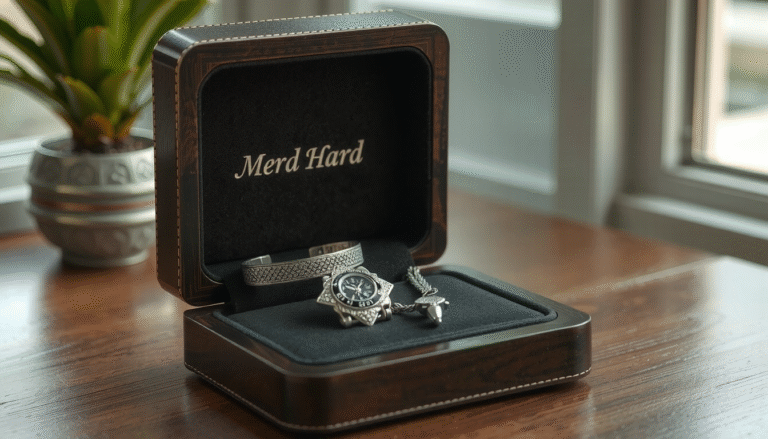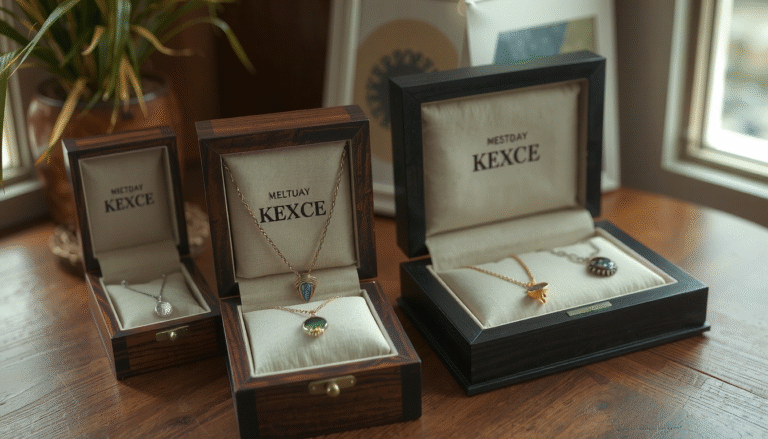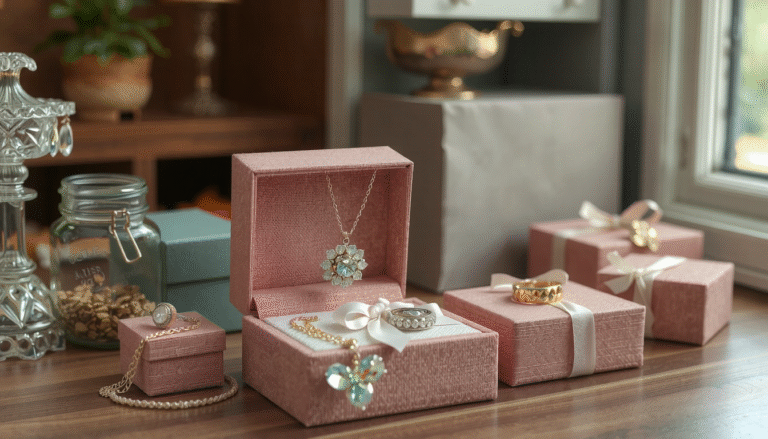The intense, light-absorbing black color glows. Complex, intricately painted images communicate historical events. Brass fittings keep the coolness inside. A black lacquer jewelry box made in China is really an inseparable part of a treasure chest. It is more than just a place to keep your things. It is a piece of art with thousands of years of culture and beliefs embedded in it.
This guide will be your expert companion. Together we will immerse in the fascinating history of these beautiful items. We will also interpret the significant symbolism they carry. At the end of it all, you will get guidelines on how to choose, value, and take care of the piece you have.
The Lacquer Legacy: The Ancient Chinese Lacquer Art
To see the beautiful black lacquer jewelry box you have in the right light, you need to start with the antiquated art of lacquerware. This is not the latest finish; this is a time-tested technique that has been perfected over the ages.
What is Authentic Lacquer?
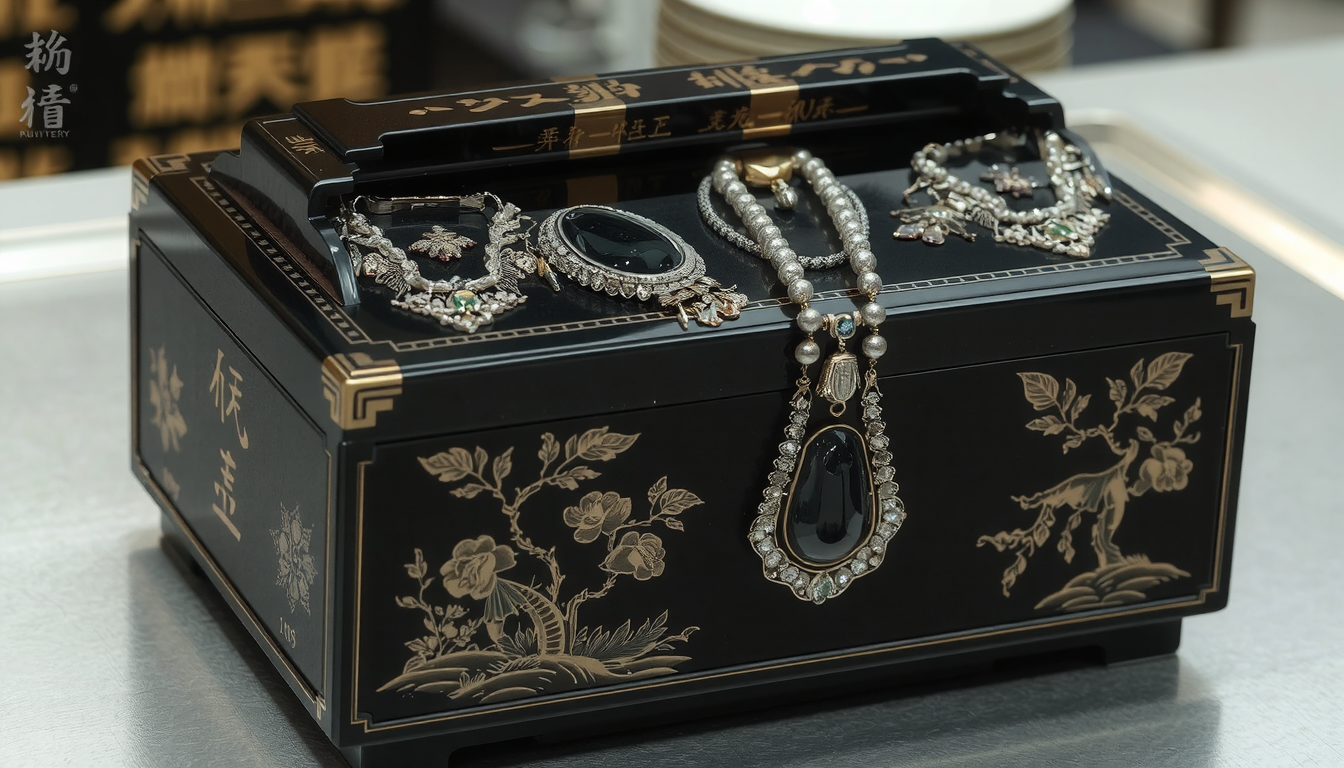 Original Asian lacquer is a natural resin extracted from a tree. The tree, which is a variant of the poison ivy tree, is called Toxicodendron vernicifluum. The practice of this sap being used as a coating due to its durability and beauty has been recorded for over 7,000 years in China. Unbelievably, the samples found from those times are still in pristine condition.
Original Asian lacquer is a natural resin extracted from a tree. The tree, which is a variant of the poison ivy tree, is called Toxicodendron vernicifluum. The practice of this sap being used as a coating due to its durability and beauty has been recorded for over 7,000 years in China. Unbelievably, the samples found from those times are still in pristine condition.
This organic product is in no way comparable to contemporary “lacquer” paints. These consist of synthetic materials like shellac or nitrocellulose. Lacquer does the opposite of those; it is a durable, hard, waterproof, and bright surface. Its durability is unmatched.
A Step-by-Step Creation
Devoting time and effort is the key to producing an artistic lacquer item. The process which is multi-faceted has not altered over the centuries. This speaks volumes about the craftsman who dedicates himself fully to his work.
- The Base: A precisely formed wooden core is the first step in this process. This wood is reshaped and smoothed to perfection, forming the body of the jewelry box.
- The Coating: Many, and in some cases even more than a hundred, diaphanous layers of raw lacquer are painstakingly applied to the core. Each layer must be the same.
- The Curing: The object is placed in a warm, humid, and dust-free chamber. Here, the lacquer doesn’t “dry” but cures through a chemical process called polymerization. This forms a hard, durable shell.
- The Polishing: After curing, each layer is hand-polished with fine abrasives. These include powdered stag horn or whetstones. The result is a very deep, almost mirror-like gloss.
- The Decoration: Finally, master artists decorate the surface. They use hand-painted scenes, intricate carvings, or delicate inlays of mother-of-pearl, jade, or ivory.
A Colorful Past
Lacquerware was one of the major artistic items that were exported from ancient China. It was in high demand because of its elegant look and hardness. The material’s function was continually changed throughout different dynasties. Lacquerware, which was simple and yet magnificently designed during the Han Dynasty, was transformed into exquisite decoratives in Tang and Ming periods. The long journey of lacquerware as an art form is a clear depiction of its transformation, from a mere coating to a luxury and art. Such history has reached us via each antique Chinese black lacquer jewelry box.
Interpretation of the Symbols: What Are the Arts on Your Jewelry Box Saying?
The themes and designs that a Chinese black lacquer jewelry box features are not just fanciful choices. They are a highly developed mode of communication. They form an unbroken array of happy symbols interweaving the wishes of happiness, longevity, and wealth. Learning this “language” allows you to personalize the box from merely another handsome object to a storied one.

A Dictionary of the Most Cunning Designs
The topic of decoration on your box is not just random. It is meant to convey fortune to the new owner. Below are some of the most frequent motifs that are used and their profound significance.
| Symbol/Motif | Visual Description | Symbolic Meaning |
|---|---|---|
| Dragon & Phoenix | A huge, serpentine dragon coupled with a glorious, flirtatious phoenix. | The absolute icon of marital happiness and balance is the dragon and phoenix. The yang dragon refers to the emperor, and the yin phoenix represents the empress, thus indicating perfect union and imperial power. |
| Peonies | Lush flowers in full bloom, typically painted in fiery reds and vivid pinks. | As the “king of flowers”, the peony is a famous emblem of prosperity, prestige, high social status, and femininity. |
| Cranes & Pine Trees | Snowy cranes in the air or standing by an old pine tree. | Both are very important symbols of longevity and endurance. The crane is said to live for a thousand years, and the evergreen pine is a symbol of resilience and endurance. |
| Butterflies | Pretty butterflies seem to be dancing among flowers. | The timeless sign of love, particularly young love and happiness. A pair of butterflies depicts a cheerful and faithful marriage. |
| Mother-of-Pearl Inlay | Shining pieces of shell are snail-like attached to the lacquer. | Often, they depict elegant scenes from palace life, lush gardens, or characters from folk tales. The material itself expresses high value, delicateness, and beauty. |
| Landscapes (Shan Shui) | Schematic-looking mountains, streams, and trees which create an ethereal and at times spiritual effect. | Represents the Taoist pursuit of a life well-lived. It evokes a state of relaxation, as well as contemplation. |
Shopping Guide for Choosing a Chinese Black Lacquer Jewelry Box
Purchasing a quality piece is essential, be it a part of a collection or a standalone piece. Having a necessary skill will allow you to find the best. This guide is for detecting quality and making the right choice, whether you decide to buy a vintage or modern Chinese lacquer box.
Significant Aspects to Inspect
 Please note that spotting minute details will sharpen your observation. Such traits differentiate a true artwork from a mere decoration.
Please note that spotting minute details will sharpen your observation. Such traits differentiate a true artwork from a mere decoration.
- The Finish: Only a first-rate piece of furniture presents a deep, shiny glow that seems to come from within. It’s not a fleeting, plastic-like shine. Clear every part and every surface. If the vintage item has minor signs of age, that is no problem. But should you find major cuts, chips, or extensive “crazing” (a fine crack network in the lacquer) be sighted, avoid the piece.
- The Artwork: Look at the artwork from up close. Hand-painted work will show fine brushstrokes and subtle variations in color and line. Contrasts here are weak, like a decal or print that looks totally flat and uniform. For mother-of-pearl inlay, observe whether the pieces are at the same level with the surface and if all are attached securely.
- The Construction: The material utilized in a high-end box is dense. Pay attention to the joint work and a tightly fitted lid. If there’re some drawers, check if they work perfectly, i.e., if they slide with ease without any clogging or shaking.
- The Hardware: The brass/metal hinges, lock plates, and pulls should be of good quality and tightened securely. On vintage chests, original hardware with a natural patina adds to the authenticity and thus gives additional value.
Distinction between Vintage and Modern
Vintage and modern both have pros and cons. A vintage or antique Chinese black lacquer jewelry box will usually be casually marked. It will have signs of play that give it character. Its inlay craft may even be more intricate, it has a construction that is specific to its era.
Modern items, on the contrary, own unblemished surfaces. They may also be more multifunctional, such as a greater selection of organizational options for the jewelry. For the best quality and customized or new designs, you can always contact professional and specialized suppliers like Jewelry Box Supplier Ltd who are really good at this craft.
Possibilities for the Purchase
You never know what treasures might be found! The antique market, estate auctions, & the internet are great places for vintage finds. For instance, when looking online, you can find many sellers promising high-quality items as long as they include several clear pictures and specific information. You can have a glance through several designs of Asian jewelry boxes including simple to elaborate types here.
Legacies of Beauty: Caring for Your Lacquer Jewelry Box
Treating your lacquer jewelry box right is of utmost importance for making your investment safe. As a result, the box would be a beautiful heirloom for future generations. I have learned that acquiring such boxes takes time and using a gentle approach serves as the best methods. The feeling of a soft, lint-free cloth gliding over a cool, smooth lacquer surface that has just been cleaned is one of the joys of having ownership.
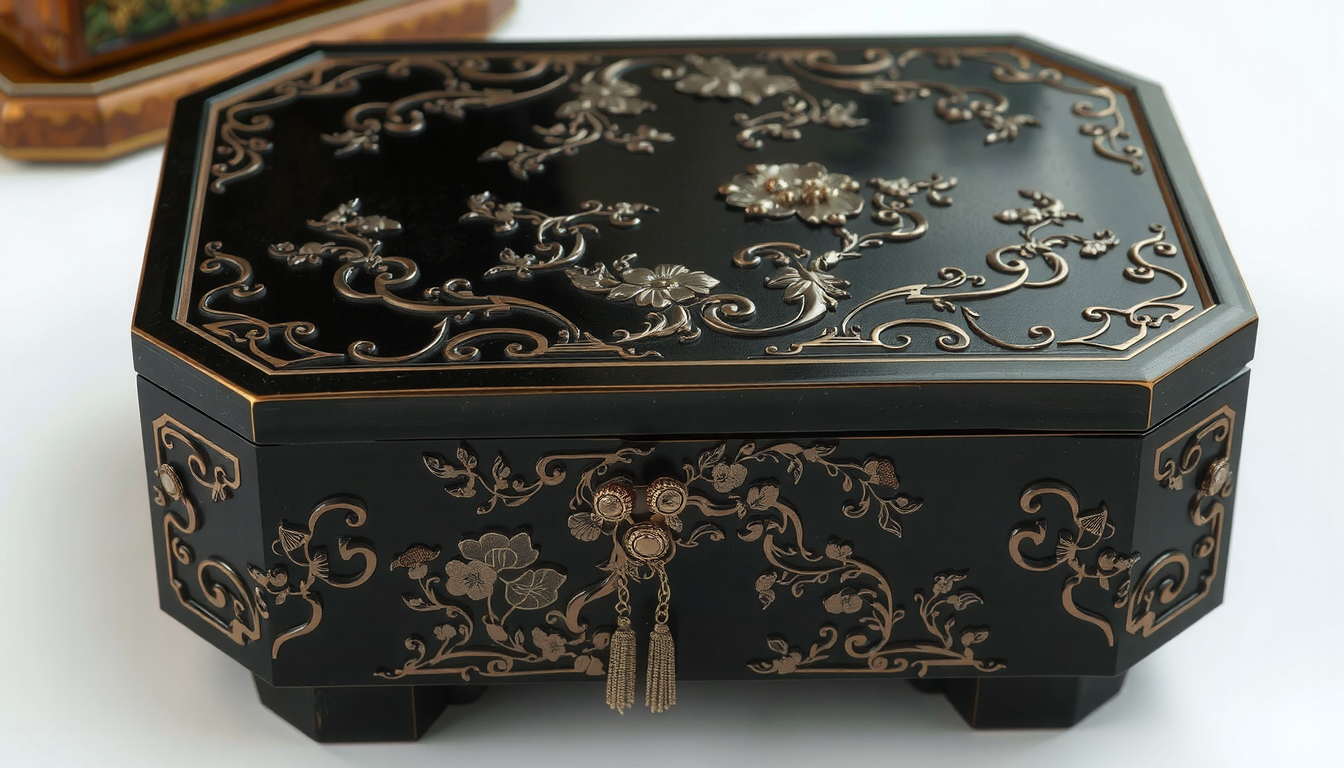
The “Dos” of Lacquer Care
- Do dust regularly with a very soft, dry, lint-free cloth. A microfiber, silk, or well-washed cotton cloth is ideal.
- Do keep the box away from direct sunlight and sources of heat or cold. This includes radiators, air conditioning vents, or open windows.
- Do try to maintain a stable environment. Lacquer is most vulnerable to rapidly changing temperatures and humidity. This, in turn, may cause the wood underneath to expand or contract, thus cracking the lacquer.
The “Don’ts” of Lacquer Care
- Don’t ever use commercial furniture polishes, waxes, oils, or any cleaner containing alcohol, ammonia, or other abrasive chemicals. Implementation of these products will for sure damage the delicate finish forever.
- Don’t use water. The only time when a damp cloth is recommended is when you absolutely have to clean a sticky spot. The light cloth should be the only one which is moist while directly afterwards you have to use a separate soft, dry cloth to wipe it dry.
- Don’t put sharp, rough, or heavy items on this surface. This is easily enough to create scratches or depression marks.
Questions that are Most Asked (FAQ)
Here you will find answers to some of the frequently asked questions posed by both collectors and enthusiasts.
Is the value of black lacquer jewelry boxes high?
The price tag of a chinese black lacquer jewelry box can significantly fluctuate. Factors such as age, condition, craftsmanship quality, and intricacy affect it much. A rare, authentic piece from Ming or Qing dynasty, in perfect condition is very valuable. However, the mass-production decoration boxes available today are far less expensive. Sometimes the actual worth is in how much the piece means to the individual.
What sets Chinese lacquerware apart from Japanese ones?
These are two fabled and revered historical heritages. Thus, broad generalities could be made. For example, in case of Chinese lacquerware, it is often colossal, carved designs (like Cinnabar) or bright, painterly landscapes populated with figures and bushes; Japanese lacquerware with its precision, constraint, and also the unique use of popped gold powder & silver known as Maki-e.
How can I distinguish real mother-of-pearl inlay from fake ones?
Genuine mother-of-pearl showcases a natural iridescent effect. When the light of the room is tilted towards the box, the colors coming from the shell should be shifting and the spectrum should look like a rainbow-color one. In contrast, plastic or synthetic materials will have a very flat and uniform sheen without this effect. In addition, genuine shells are known to have distinguished, natural anomalies.
Can I get my lacquer box repaired if it is damaged?
Yes, but it is a special environment and labor usually comes at a high price. Minor surface scratches are very difficult to fix at home without causing more damage. For significant issues like deep cracks, flaking lacquer, or broken parts, it is essential to consult a professional art conservator or furniture restorer. They must have specific experience with Asian lacquerware.
Why is my vintage jewelry box marked by red felt or paper on the inside?
The color red is associated with a plethora of good things in Chinese culture; it is the most powerful and optimally auspicious color. Bringing luck, happiness, and good health, it is believed to keep evil at bay. The lining of the interior of a jewelry box made of red fabric or paper was often decorated with elaborate designs. It was not only a decorative touch but a way to impart these blessings to the owner and protect the precious jewels that were kept inside.


